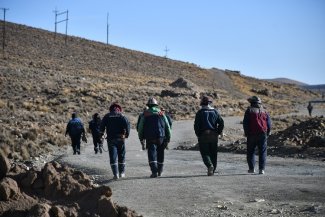A food delivery courier watches delivery backpacks burn in front of the Barcelona headquarters of the Spanish food delivery start-up Glovo on 26 May 2019. Workers protested poor working conditions after a road traffic accident resulted in the death of a delivery rider.
As Covid-19 forces citizens around the world into lockdown and food delivery workers go into overdrive to provide relief to customers, a new report has shone a light on the poor working conditions faced by food couriers globally, as well as some of the steps that workers are taking to challenge the status quo.
The recent FES study Global labour unrest on platforms. The case of food delivery workers looks at six global food delivery brands operating in more than two global regions – Uber Eats, Just Eat, Deliveroo, Foodora, Zomato, and Glovo – in addition to a further 12 companies that operate regionally. Between them, these 18 companies deliver cooked and prepared food to customers in 95 countries.
The research, which was based on the Leeds Index – a unique dataset logging plat-form labour unrest around the world – found that there had been 527 incidents of labour unrest from 1 January 2017 to 20 May 2020, across 36 different countries – something the report authors describe as “a remarkable number of protests”. Most of the incidents took place in Europe, followed by Asia, which accounted for around a quarter of all incidents, while one-sixth took place in South America.
The research reveals “a gradual increase in protests from early 2017 to a significant spike in the third quarter of 2019, with a notable decline since then”.
At a national level, the highest number of incidents occurred in China, followed by the UK, Spain and then Argentina.
In terms of single companies, labour unrest was most prevalent in the UK-headquartered food delivery platform Deliveroo, with most incidents taking place in Europe, specifically in the UK, Spain, France, Belgium and the Netherlands.
“Deliveroo was operating in 16 countries but interestingly there was a spillover effect, so grassroots unions were reaching out to other unions in other countries and providing each other with flyers and material,” says Vera Trappmann, one of the co-authors of the report and an associate professor in work and employment relations at Leeds University in the UK. “There was this transnational feeling of ‘they [our peers] have done something and we want to do something too.’’” There were also a number of cases where labour unrest traversed multiple companies and multiple locations, “suggesting platform workers are developing the capacity to wage concerted campaigns and build solidarity,” the report notes.
Poor pay, the most dominant driver of labour unrest globally
Pay was the most dominant driver of labour unrest across all regions, except for in the United States, where employment status was the most significant factor. Workers demanded higher pay, healthcare provisions, and frequently criticised the insufficient protective gear provided by platform companies such as PedidosYa, Glovo, SinDelantal and Uber Eats.
In South America, health and safety was the main source of disquiet, an issue that has really come to the fore since the start of the Covid-19 pandemic. While food delivery workers have been recognised as essential workers, at the same time they are being locked out of fundamental labour rights because they are forced by the platform companies to work as self-employed contractors. “On one hand it has to do with the risk posed by the rising number of [coronavirus] cases and on the other hand that they lack health insurance, so workers are operating entirely on their own risk,” Trappmann explains.
“What’s interesting is that we are seeing a variety of protests – not just strikes, which are the classic model,” says Trappman, who plans (along with her co-researchers) to enlarge the database and make it publicly available online for labour activists around the world. Although strikes and logoffs were the most frequent type of action taken, they were closely followed by demonstrations, legal actions and institutionalisation (which refers to worker protests that lead to institution building, such as the formation of works councils or the negotiation of collective agreements). “It is quite likely that in countries like China workers were relying more on logoffs and disruptive actions in the absence of an open media system that would allow any effect following demonstrations,” the authors noted, “while legal action might be more likely in countries like Australia, given its historical tradition of legal arbitration.”
Informal groups involved in the majority of events
Platform labour protest tends to be led from the grassroots, with informal groups of workers playing a vital role in the vast majority of direct action. Even though most individual protests tend to involve less than 100 workers and last less than a day, the report notes that the duration of a protest does not determine its efficacy.
Informal groups of workers were the main actors of labour unrest in Asia and South America. Informal groups of workers were slightly less prominent – though still ubiquitous – in Europe, and much less involved in North America and Australia. “It’s mainly the workers who directly raise their voice and take action, often with little reliance on union representation,” say the report authors.
However, unions were involved in more than half of the labour unrest noted by researchers. While this was pretty evenly split between established trade unions (involved in 27.6 per cent of cases) and independent unions (26.9 per cent), there were large regional differences.
For example, mainstream trade unions were the dominant actor in Australia (68.8 per cent) and were relatively active in Europe (37 per cent) but were virtually absent in Asia (a mere 1 per cent). Where unions did get involved, grassroots unions tended to support strikes and logoffs while mainstream unions were active in demonstrations and in launching legal action.
For researchers, the last few years of platform worker unrest demonstrates a broadening of the concept of associational power, which is usually identified with the collective organization of workers through trade unions. What we are seeing with platform food workers is “militant, self-organised collective action”, according to the report, agitated for by workers without formal labour rights, and for whom institutional power is “often an aim of collective action rather than a pre-condition or an outcome”. As a result, “the associational power of workers is rising,” says Trappmann.










